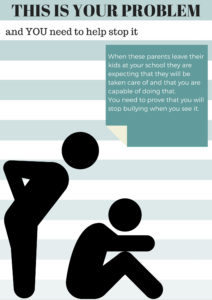Torina Gedler, Angela Geametto, Darpan Mehta, Pamela Mulhern
Bullying Final Post Draft
We’ve chosen two posters that a) Encourage students to get motivated by the Stand for the Silent program and b) Reminds the administration that tackling bullying is a big part of their responsibility. Our research indicated that the administration is usually very good at handling bullying cases that are overt (actual physical abuse such as punching or kicking or overt verbal actions such as name-calling and insulting) but not that great at handling the more covert aspects of Bullying. Covert bullying is the kind of bullying done out of sight and involves inflicting harm by damaging another’s social reputation, peer relationships and self-esteem. I.e. involving more relational bullying and threatening looks or hand gestures. Therefore, our posters need to tackle the more covert cases which we realize will be more difficult as we’re trying to bring about systemic changes and not just trying to implement a bullies get punished method.
As we’ve seen from our readings in this class and from the video ‘Bullying’, the conventional methods that have been used so far that focus more on an individual’s psyche don’t really address the problem. The bully is still likely to continue bullying. Instead, our method focuses on treating this as a systemic problem that can only be truly eradicated through making a change in student perceptions about bullying which the first poster aims to do. It is also very important to have a simple poster that encourages a child to look up a program that has much more information in it. Treating bullying is a vast subject and it’s more feasible to provide a starting point via a poster rather than cramming all the information in the poster itself. It also plays on the curiosity of students who are much more likely to learn that way instead of being subjected to posters and material that they are forced to learn.
Giving the bystander room to explore also addresses one of the main challenges of Bystander Programs. Most bystanders don’t step up even when they know bullying is occurring is because of lack of awareness of what steps to take to help stop the bullying. A Lack of awareness leads to lack of courage to step in as they aren’t sure as to what to do. A lot of bystander programs encourage students to step up but the students need to know how or want much more information before they take any action. Consider, also that different students are satisfied with different levels of awareness. Student ‘A’ might step when bullying occurs and tell the bully to cut it but Student ‘B’ might want to know more about what to do if the bully changes his focus to them or ignores them. A self-motivated approach that we propose via having a simple, yet inviting poster is to let the student decide how much awareness he/she needs herself before acting to do something.
The administration needs to realize the effect that they can have on preventing and stopping bullying. Student’s are not likely to report their problems to the administration if they feel nothing is being done when they do report. The administration needs to do continuing education in these areas throughout their time teaching as we learn new techniques to deal with bullying all the time. Bullying is also something that every instructor will see at some point in their career and the importance of combating bullying needs to be remembered with each student encounter. Parents are leaving their kids at school with the belief that they will be in safe capable hands and administrators need to realize how important that makes their jobs. The internet opens a wide area of possibilities for administrators to help combat bullying in their own school. They can reach out to other schools that have had success in lowering incidence of bullying on what they did and how that worked. There are various workshops available to administrators currently on the subject of bullying and each school district should research the best one for their school to take part in.
The administrators also have the responsibility to bring bullying prevention exercises to the students. The administration will have to take what they learn from their own experiences to the students in a way that the students will take it seriously. Administration needs to show the students the importance of the program and the gravity of the situation for the program to have any success. Once the workshop of sort has been presented to the students the administration should make available options for students to join Stand for the Silent or to encourage the students to making their own anti-bullying program. This type of take charge stance on bullying should especially be encouraged in the students that have the most influence and power in the school such as those on the student council. This would be important because these students are essentially the administration of the students and they already know that they have to power to make changes. The administration needs to realize that while they have great power to end bullying they also still need the students’ cooperation and help in making these important changes.
Research
http://www.nsvrc.org/bystander-intervention-campaigns-and-programs
https://www.notalone.gov/assets/bystander-summary.pdf
http://www.bullyingnoway.gov.au/teachers/facts/types.html




Recent Comments